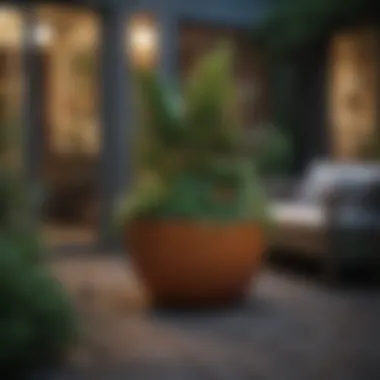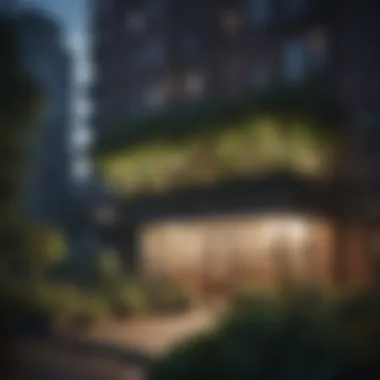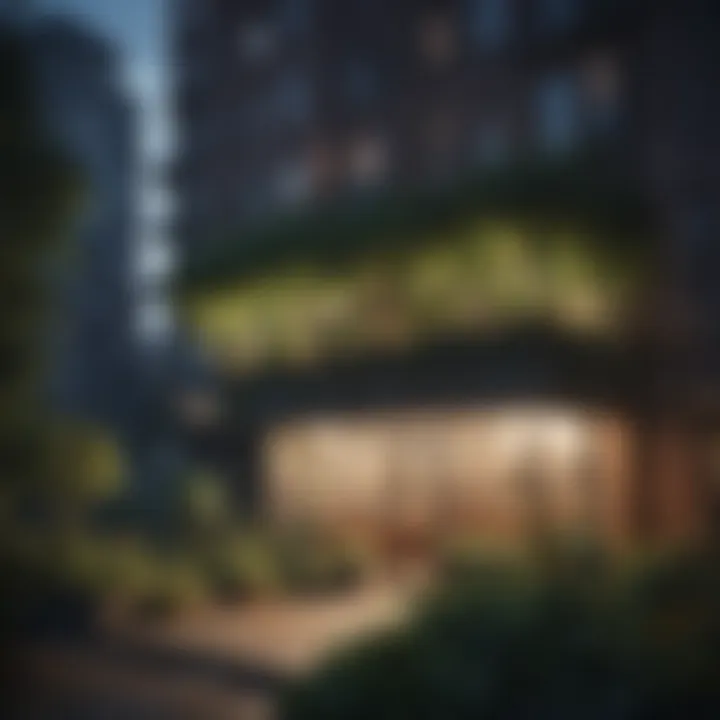Innovative Garden Ideas for Apartment Dwellers


Intro
Gardening in an apartment does not need to be limited or bland. Apartment dwellers face unique challenges, such as limited square footage and a lack of direct sunlight. However, these constraints can inspire creativity in garden design. Innovative gardening ideas can transform even the smallest space into a vibrant oasis. This article will guide you through various approaches, from vertical gardens to container setups, ensuring that you maximize your apartment's potential.
Understanding how to incorporate greenery into urban living is key. The benefits span mental well-being to enhanced aesthetics. Thus, we will explore practical strategies and plant selections suited for various apartment conditions. Each tip aims to cultivate lush surroundings, regardless of spatial limitations.
Featured Homes
Gardening has become an integral aspect of home design, particularly in urban dwellings. Understanding the features of apartments that accommodate innovative gardening solutions is crucial.
Architectural Styles
Modern apartments often include open layouts that invite the placement of greenery. High ceilings and large windows provide potential for vertical gardening. Notably, loft apartments offer ample wall space suitable for climbing plants and shelves. Additionally, some developments feature balconies where pots can thrive, enabling outdoor gardening even in the heart of a city.
Unique Design Elements
Incorporating innovative garden designs can complement an apartment's aesthetic. Utilizing shelves for plants not only saves floor space but adds a visual appeal. Hanging planters are also a unique design choice, elevating the greenery to eye level. Furthermore, the use of natural materials, such as wood or ceramic pots, enhances the overall ambiance.
These elements collectively contribute to a serene atmosphere in urban settings, achieving an inviting environment that embraces the comforts of nature.
Incredible Locations
Whenever considering garden designs for apartments, think about your environment and its characteristics.
Geographic Highlights
If your apartment is located in a sunny region, you will be able to enjoy a wide range of plants that flourish in bright light. Urban areas often have diverse climates, affecting what types of plants will thrive. It is wise to select flora based on local weather patterns and seasonal variations.
Cultural Significance
Gardening is deeply ingrained in many cultures. For instance, in places like Southeast Asia, small gardens are integrated into urban life as a source of herbs and vegetables. Understanding cultural practices can inspire how apartment dwellers approach gardening, enhancing their connection to the space.
"Urban gardening fosters community and cultivates resilience by providing healthy food options in cities."
Preamble to Apartment Gardening
Apartment gardening has emerged as a significant topic among urban dwellers seeking to infuse their living spaces with greenery. The importance of this subject lies in its potential to address the challenges faced by city residents. Gardening in limited spaces not only promotes a sustainable lifestyle but also enhances mental well-being. Creating a personal garden, even within the confines of an apartment, allows individuals to connect with nature.
Gardening offers various benefits, such as improving air quality, providing food sources, and cultivating a calming environment. Furthermore, gardening is an effective way to express creativity. Apartment gardening enables residents to curate their green spaces to reflect their tastes and preferences. This article will delve into different methods and solutions tailored specifically for apartment dwellers.
Defining Urban Gardening
Urban gardening refers to the practice of cultivating, processing, and distributing food in and around urban areas. It encompasses several types of gardening, including rooftop gardens, window boxes, and container gardens. This form of gardening emphasizes the use of available space, often in non-traditional ways. It allows city residents to partake in the benefits of gardening, from growing herbs to decorating their homes with plants.
Urban gardening can also be viewed as a response to urbanization, as increasing populations move into cities where green spaces are scarce. By gardening in urban settings, dwellers are contributing to food sustainability and environmental health. It's essential for apartment dwellers to understand that urban gardening extends beyond simply growing plants; it is about creating a lifestyle that embraces nature amid concrete.
Challenges of Apartment Gardening
Apartment gardening, while rewarding, comes with its own set of challenges that can deter some would-be gardeners. One significant issue is the limited space that residents often have at their disposal. Many apartments feature small balconies, window sills, or indoor spaces that are not conducive to traditional gardening practices.
Access to natural light is another challenge. The layout of an apartment can obstruct sunlight. Consequently, indoor plants may struggle to grow without adequate light.
Additionally, the diversity of climates presents hurdles. Urban environments may lack many soil resources necessary for healthy plant growth, especially in high-pollution areas.
Apartment dwellers must also consider their commitment level. While some plants require minimal care, others need more attention. Managing a garden in a confined space can become overwhelming without proper planning, making it vital for individuals to choose plants that suit their lifestyle.
"Gardening in small spaces requires creativity and adaptability. Embracing limitations can lead to innovative solutions and delightful outcomes."
In summary, understanding the significance and challenges of apartment gardening can prepare residents for success. The journey into apartment gardening begins with awareness and careful planning. This article aims to guide readers through each step to cultivate their own green oasis, regardless of spatial constraints.
Assessing Your Space
Assessing your space is an essential first step in creating an indoor garden in an apartment. Many urban dwellers have limited square footage, and understanding what is available can help make the most of that area. This process goes beyond just visualizing where to place plants. It involves careful consideration of several factors that affect plant health and overall success in gardening. Without proper assessment, you could end up with plants that don't thrive in your environment.
Measuring Available Area
Measuring your available area means knowing exactly how much space you have to work with. This measurement can be more intricate than it seems. Begin by taking a tape measure and measuring the length and width of the surfaces where you plan to place planters or containers. Don’t forget to measure wall spaces too, as these areas can be used for vertical gardens or hooks for hanging plants.
When you know your specific dimensions, you can choose the appropriate containers and layouts. It is also important to leave enough space for accessibility and maintenance. Consider pathways for moving around your plants, especially if you plan to have larger pieces. Correctly measuring ensures that you will not overcrowd your living space, creating a tranquil environment where plants can flourish.
Identifying Light Sources
Light is a critical component for any garden, especially in apartments where natural light can be limited. Identifying light sources allows you to understand how much direct or indirect sunlight your plants will receive.
Take the time to observe your space at different times throughout the day. Note any windows and their orientations; south-facing windows typically provide the most sunlight, while north-facing ones offer the least. Assess whether light is blocked by furniture, trees, or building structures. This knowledge is vital for selecting the right plants. Some plants thrive in low light, while others require significant sunlight exposure.
Creating a chart or a simple checklist of the types of natural light available can be beneficial. You may even find it useful to note the times when light is strongest. Awareness of these elements prepares you for making informed choices regarding plant selection and placement.
"Gardening in an apartment requires careful planning, especially when it comes to space and light. Every inch counts."
Understanding the layout of your apartment and identifying where light comes from can drastically influence the success of your indoor garden. Each decision made during this initial assessment phase leads to a flourishing and visually appealing living space.
Types of Gardens for Apartments
Apartment living offers unique challenges for gardening enthusiasts. However, there are numerous approaches to creating lush and inviting green spaces. Choosing the right type of garden can significantly enhance your living environment. It allows for personal expression while contributing positively to your home’s ambiance. Understanding the different types of gardens suitable for apartments is crucial for maximizing limited space, providing aesthetic value, and promoting mental well-being. Furthermore, with the right selection, one can turn a small balcony or even a kitchen counter into a miniature paradise.
Container Gardens
Container gardening serves as an accessible option for many apartment dwellers. It involves growing plants in containers, which can be arranged in various ways depending on available space. This method is beneficial as it allows flexibility; you can move containers to catch the sun or rearrange them to suit your preferences. Containers come in different sizes, shapes, and materials, from classic terracotta pots to modern resin planters.
The advantages of container gardening include the ability to control soil quality more effectively, as well as offering better drainage compared to in-ground planting. Additionally, container gardens can be designed to fit even the smallest spaces. Herbs, flowers, and vegetables thrive in pots. Ensuring the right plant doesn’t become root-bound is essential to maintain a healthy garden.
With proper care, container gardens provide easy access to fresh produce and beautiful blooms year-round.
Vertical Gardens
Vertical gardening is another innovative solution for apartment dwellers where floor space is limited. This gardening style focuses on growing plants upward, using walls, trellises, or shelving systems. It is a brilliant way to maximize limited vertical space while adding layers of greenery to your living space.
Vertical gardens can incorporate a variety of plants, including succulents, ferns, and climbing vines. They create a dramatic visual impact and can also improve air quality inside the apartment.


One important consideration is the structural support needed to maintain weight and ensure water drainage. Lightweight materials can aid in this, making it easier to manage.
Using plant pockets, wall-mounted planters, or even repurposed wooden pallets can effectively establish a vertical garden. This not only enhances aesthetics but can efficiently be tailored to suit specific light conditions in various areas of the apartment.
Indoor Gardens
Indoor gardens breathe life into apartment interiors. They provide a personal oasis where one can grow plants completely indoors, regardless of external weather conditions. A well-thought-out indoor garden leads to improved air quality and adds to the overall ambiance of the space.
When creating an indoor garden, consider factors like light availability. Areas with ample natural light are best for many indoor plants. However, for places lacking sunlight, one can utilize grow lights to promote plant growth.
Common choices for indoor gardens include houseplants like pothos, snake plants, and peace lilies. These plants are not only attractive but also low-maintenance and help purify the air. Indoor gardening can take many forms, from utilizing shelves filled with plants to creating a more traditional setup with pots on windowsills.
Through careful planning and consideration of available resources, one can create an indoor garden that complements their lifestyle and enhances the urban living experience.
Choosing the Right Plants
Choosing the right plants is crucial for successful apartment gardening. In a confined space, plant selection can directly impact not just aesthetics, but also the overall health of the plants and the comfort of the living environment. The right plants can flourish in limited light, low humidity, or small containers, providing a lush oasis within urban confines. Additionally, plants can significantly improve indoor air quality, creating a more pleasant atmosphere in which to live and work.
When selecting plants, consider your lifestyle and the time you are willing to invest in care. Low maintenance options are ideal for those new to gardening or who have busy schedules. Understanding your environment is also essential. Some plants thrive in bright, indirect light, while others can adapt to low light conditions.
In essence, the right plant choices will enhance not only the visual elements of your space but will also cater to your emotional and environmental needs.
Low Maintenance Plant Options
Low maintenance plants present a perfect solution for apartment dwellers who wish to incorporate greenery without the demanding chores of gardening. These plants typically require minimal watering and can withstand varying light conditions. Here are a few options:
- Snake Plant: Known for its resilience, the snake plant tolerates neglect and low light.
- ZZ Plant: This plant thrives on low light and infrequent watering, making it ideal for new gardeners.
- Pothos: With its trailing vines, pothos requires little care, adds beauty to spaces, and thrives in various environments.
- Spider Plant: Not only is this plant easy to care for, but it also propagates well, allowing you to expand your collection with minimal effort.
These plants allow you to maintain a green space with little effort, providing both beauty and a bit of nature without demanding too much attention.
Air-Purifying Plants
Air quality within apartments can often be compromised due to urban living. Choosing air-purifying plants can mitigate some of these issues, making for a healthier indoor environment. These plants filter toxins from the air and can contribute to an overall sense of well-being. Here are some notable examples:
- Peace Lily: This plant not only blooms beautifully but is also known to filter harmful chemicals like formaldehyde.
- Boston Fern: Effective in removing formaldehyde, this lush plant thrives in high humidity and indirect light, making it suitable for bathrooms.
- Areca Palm: This palm is ideal for larger spaces and can act as a natural humidifier while removing toxins such as xylene and toluene.
- Rubber Plant: Known for its glossy leaves, the rubber plant helps cleanse the air, making it a stylish and functional choice.
By selecting air-purifying plants, apartment dwellers can create a sanctuary that not only looks good but also actively contributes to better air quality. Incorporating these into your living space is a practical step toward improving both health and happiness.
"Plants have a transformative power in urban living, enriching spaces and enhancing well-being."
Implementing Vertical Gardening Techniques
Vertical gardening is an innovative response to the constraints of urban living. This technique allows apartment dwellers to cultivate a garden without requiring extensive horizontal space. It is a smart solution that can transform an otherwise dull wall into a vibrant green display. Benefits of vertical gardening include maximizing limited space, improving indoor air quality, and adding aesthetic value to your home. A well-planned vertical garden can act as a natural air filter and can create a soothing atmosphere that enhances mental well-being.
When considering vertical gardening, several important elements must be taken into account. One of the key considerations is the selection of suitable plants that thrive in an upright arrangement. Adequate light exposure and watering techniques must also be tailored to the specific plant choices. Being mindful of these aspects can significantly increase the chances of success in urban gardening.
Materials Required for Vertical Gardens
Creating a vertical garden requires specific materials that support plant growth while taking up minimal space. Here are some essential items you might need:
- Plant Supports: Trellises, wall-mounted planters, or vertical frames can offer vital support for your plants. These structures ensure that plants grow upwards rather than outwards, conserving space.
- Containers: Opt for lightweight pots or modular planting systems that can be easily mounted on walls. Ensure that they have adequate drainage holes.
- Growing Medium: Use a high-quality potting mix that provides adequate nutrients and drainage. Some vertical planters may require a soilless mix for efficient growth.
- Watering Systems: Consider drip irrigation systems or self-watering components to make sure your plants receive consistent moisture, without the need for daily attention.
- Fertilizer: Select a slow-release organic fertilizer to provide ongoing nutrients to your plants.
- Tools: Basic gardening tools such as scissors, gardening gloves, and watering cans will help maintain your vertical garden.
Design Ideas for Vertical Spaces
The design of your vertical garden can significantly influence its appearance and functionality. Here are some ideas to consider:
- Wall-Mounted Planters: Arrange plant containers in a staggered or uniform pattern across a wall. This method creates a visual impact while ensuring each plant gets sufficient light.
- Living Walls: Incorporate a living wall system, which consists of panels or modules that hold a variety of plants. This not only looks striking but also enhances insulation and air quality in your apartment.
- Repurposed Materials: Use recycled materials like old pallets, shoe organizers, or even plastic bottles to create unique and eco-friendly vertical planters. These options add character to your space.
- Thematic Plant Selection: Choose plants that complement each other in terms of color and texture. Incorporating a mix of trailing vines and upright species can also create visual interest.
"Vertical gardening not only saves space but also allows for creative expression in confined urban environments."
- Lighting Considerations: Depending on the location of your vertical garden, install grow lights to support plant growth in low-light situations. Ensure that the lights can be easily adjusted as plants grow.
Implementing these ideas can result in a dynamic vertical garden that not only serves a practical purpose but also brings a touch of nature into apartment living.
Maximizing Container Gardening
Container gardening is a vital concept for urban dwellers who wish to bring nature into their living spaces. This approach allows individuals to utilize limited space effectively while offering flexibility in plant selection. The importance of this topic lies in its ability to enhance not just the aesthetic appeal of an apartment, but also its ambiance and potentially its air quality. Containers can range from traditional pots to more innovative designs, allowing residents to create unique green spaces even in the most confined areas.
Selecting Appropriate Containers
Choosing the right container is crucial in container gardening. When selecting containers, consider a few essential factors:
- Material: Containers can be made from plastic, clay, or metal. Plastic is lightweight and often less expensive, while clay offers natural breathability, benefiting the roots. Metal can retain heat, which may help in colder climates but can also lead to overheating in direct sunlight.
- Size: The size of the container should match the plants you aim to grow. For instance, herbs need smaller containers, while larger plants such as tomato or pepper plants require more substantial space for root expansion.
- Drainage: Proper drainage is vital to prevent waterlogging, which can lead to root rot. Ensure that your containers have adequate drainage holes. If a container lacks drainage, consider adding a layer of gravel or stones at the bottom to facilitate water movement.
By carefully considering these factors, you can select containers that not only look appealing but also provide the right environment for your plants.
Soil Considerations
The soil used in container gardening directly impacts plant health. The importance of good soil cannot be overstated. Here are some crucial points to consider:
- Potting Mix: Unlike garden soil, potting mixes are specifically formulated for container gardening. They typically are lighter and promote better drainage and aeration. Look for mixes that contain organic matter like peat moss and perlite to facilitate healthy plant growth.
- Nutrient-Rich Choices: Choose a soil mix that is rich in nutrients to support your plants. Some mixes may include slow-release fertilizers, which can provide essential nutrients over time.
- Water Retention: Since containers can dry out quickly, consider a soil that has good moisture retention properties. This is especially important during hotter months when the plants might require more frequent watering.
"The right soil can make the difference between a thriving garden and a struggling one."
Incorporating Herbs and Edibles
Incorporating herbs and other edible plants into your apartment garden can enhance not only the aesthetic appeal of your living space but also provide tangible benefits. Having fresh herbs at your fingertips allows for enhanced culinary experiences. This is particularly valuable for those who enjoy cooking at home, as it introduces greater variety and flavor to meals. Additionally, growing edibles contributes to a more sustainable lifestyle by reducing the need for commercially purchased produce, which often requires packaging and transport.
When selecting herbs and edible plants, it is essential to consider factors such as light availability, temperature, and humidity levels in your apartment. Moreover, herbs like basil, cilantro, and mint are known for their compact nature, making them suitable for limited spaces. Incorporating these plants can also play a crucial role in improving air quality, supporting mental well-being, and bringing a touch of nature indoors.
Choosing the Best Herbs for Small Spaces
Small spaces do not need to limit the potential of your garden. Some herbs are especially well-suited for container gardening or vertical setups. Basil is a popular choice due to its upward growth, requiring minimal horizontal space. Chives and parsley are also ideal for small pots and can be easily snipped as needed for cooking.
It is important to choose herbs that flourish under the specific conditions of your apartment. A few excellent options include:
- Thyme: Thrives in well-drained soil and requires minimal care.
- Mint: Grows rapidly and spreads out, so a confined container is necessary.
- Cilantro: Prefers cooler temperatures and is an excellent addition for diverse culinary uses.
By selecting the right varieties, even the tiniest kitchen or balcony can become a thriving herb garden.
Growing Edibles in Containers


Growing edibles in containers can be both fulfilling and manageable for apartment dwellers. Selecting the proper container is key for success. Consider the following aspects:
- Size: The container should be large enough to accommodate the root system of the plant while also allowing for drainage.
- Material: Options like terracotta, ceramic, and plastic each have pros and cons. Terracotta is porous and helps with drainage, while plastic may be lighter and easier to move.
- Drainage Holes: Ensuring your containers have proper drainage holes can prevent overwatering and root rot.
When planting, use high-quality potting soil that retains moisture without becoming compacted. Additionally, consider integrating companion planting techniques where compatible plants can promote success through mutual growth benefits. Some productive combinations include tomatoes with basil or carrots with onions.
Care and Maintenance Practices
Caring for plants in an apartment setting goes beyond simply selecting the right species. Effective care and maintenance practices are critical for the success of any apartment garden. For urban dwellers, these practices not only ensure the health and growth of plants but also contribute to improving the overall livability of the space. Proper maintenance fosters a lush environment that enhances mood and wellbeing, making apartment living more enjoyable. By committing to specific care routines, plant owners can overcome many common challenges that arise in urban gardening.
Watering Techniques
Watering is perhaps the most fundamental aspect of plant care. The amount and frequency of watering depend significantly on various factors, such as the type of plants, their growth stage, and environmental conditions. A common mistake is overwatering, which can lead to root rot and other problems. This is especially critical in containers where drainage can be inadequate. On the other hand, underwatering can cause plants to wilt and stress.
To establish a proper watering routine, consider the following strategies:
- Understand Plant Needs: Different plants have varying water requirements. Research each plant’s needs to tailor your approach accordingly.
- Check Soil Moisture: Stick a finger about an inch into the soil. If it feels dry, it is time to water. If it’s damp, wait a bit longer.
- Use Proper Techniques: When you water, aim for the base of the plant rather than soaking the leaves. This prevents fungal diseases.
- Monitor for Signs: Look for signs of distress in plants, such as yellowing leaves or drooping. Adjust your watering schedule based on these indicators.
Establishing an intelligent watering system, like a drip irrigation setup, can also help ensure consistent moisture.
Fertilizing Strategies
Fertilization is key to providing nutrients that may be depleted from potting soil over time. In an apartment garden, regular fertilization can boost growth and enhance the health of plants. Fertilizers can be organic or synthetic, each having its benefits and drawbacks. Organic options are generally safer and promote a robust ecosystem in the soil.
Here are several important considerations regarding fertilization:
- Know When to Fertilize: Plants typically need fertilization during their active growth phase, which may vary by species. Generally, spring and summer are crucial times for fertilization.
- Balanced Nutrients: Look for a balanced fertilizer that contains the essential macro and micronutrients: nitrogen, phosphorus, and potassium, as well as trace elements.
- Avoid Over-Fertilizing: Too much fertilizer can cause nutrient burn, harming the plants. Always follow the instructions on the fertilizer label.
- Consider Natural Options: Compost and worm castings can be excellent sources of nutrients without the risks associated with chemical fertilizers. Mixing these into your soil can bolster plant health over time.
Incorporating these fertilizing strategies can lead to thriving plants that contribute to a more vibrant indoor environment.
"Proper care and maintenance can transform a small apartment garden into a flourishing space, promoting a sense of tranquility and belonging."
By focusing on correct watering and fertilization techniques, apartment dwellers can enjoy a thriving garden that enhances their urban lifestyle.
Utilizing Technology for Apartment Gardening
In the ever-evolving landscape of urban gardening, technology has become a crucial component for apartment dwellers aiming to maximize their limited space. The shift towards integrating technology into gardening practices allows for greater efficiency, convenience, and creativity. These tools not only enhance the gardening experience but also provide solutions for common challenges faced by apartment gardeners.
Some key benefits of utilizing technology in apartment gardening include:
- Enhanced Monitoring: Smart devices can monitor plant health, allowing for adjustments based on real-time data.
- Automated Care: Automated watering systems help ensure plants receive consistent hydration without manual effort.
- Improved Education: Access to online resources and mobile applications provides gardeners with valuable knowledge about plant care.
- Community Engagement: Utilizing social platforms encourages collaboration and sharing of gardening tips, improving overall gardening success.
Adapting to new technologies can lead to thriving plants, even in the most constrained urban environments.
Smart Gardening Tools
The market offers various smart gardening tools that cater to apartment dwellers. These gadgets range from simple devices to high-tech systems that facilitate gardening tasks. Some notable tools include:
- Automatic Watering Systems: Devices like Gardena Water Timer are programmed to water plants at specific intervals, reducing the risk of over- or under-watering.
- Soil Moisture Sensors: Tools such as Xiaomi Soil Moisture Sensor measure moisture levels, alerting you when to water your plants.
- Grow Lights: Full-spectrum LED lights are essential for indoor gardening, replicating natural sunlight for photosynthesis.
- Plant Monitors: Devices like Parrot Flower Power allow gardeners to monitor sunlight, temperature, and moisture levels, providing a comprehensive analysis of plant health.
Implementing these tools can significantly simplify the management of a small urban garden, making it easier to maintain healthy plants and yield.
Using Apps for Garden Management
Mobile applications have transformed garden management for apartment dwellers. From planning to daily upkeep, these tools enhance productivity and facilitate the sharing of gardening experiences. Here are a few recommended apps:
- Gardenize: This app helps track garden activities, including planting schedules and maintenance tasks. Users can document their progress and share updates with community members.
- Planta: An excellent app for beginners, Planta offers care reminders based on the specific plants in your collection, reducing the chances of neglect.
- Google Keep: While not specifically a gardening app, it allows users to create lists for plant care, organize tasks based on priority, and even store images of their plants.
- My Garden: This simple app lets users catalog their plants and provides species-specific care tips, making it easier to manage diverse plant types in an apartment.
Adopting these applications enhances the apartment gardening experience by promoting organization and accountability, leading to healthier gardens made possible through careful planning.
Integrating technology into apartment gardening not only elevates the experience but also connects gardeners with vital information that promotes plant health and growth.
Creating a Microclimate
Creating a microclimate within an apartment garden is essential for optimizing plant growth and overall garden health. Microclimates are small areas where the climate differs from the surrounding environment. They can be influenced by several factors such as light exposure, temperature variations, and humidity levels. Understanding and utilizing these factors can lead to a successful and flourishing garden, even in confined spaces.
By creating a microclimate, apartment dwellers can enhance their gardening experience. This approach allows for the selection of plants that thrive in specific conditions, ensuring that they reach their full potential. In urban settings, where external conditions can be less predictable, creating a sheltered or controlled space for plants significantly contributes to their survival and growth.
Understanding Microclimates
Understanding microclimates is the first step in harnessing their potential. Different areas of an apartment can offer distinct microclimates. For example, a south-facing window will usually receive more sunlight than a north-facing window, making it a prime location for sun-loving plants. Similarly, areas near heating vents will experience higher temperatures, while corners that are shaded might create cooler conditions.
Key factors to consider when assessing microclimates in your apartment include:
- Light Availability: Observe how much natural light different areas receive throughout the day.
- Temperature Fluctuations: Note variations in temperature in different parts of your apartment. Some areas may be warmer or cooler at different times of the year.
- Humidity Levels: Plants can thrive in higher humidity, so areas near kitchens or bathrooms may be beneficial for certain species.
- Wind Exposure: A balcony or windows may introduce wind, affecting temperature and plant needs.
Enhancing Conditions for Growth
Enhancing conditions for growth in your microclimate can be achieved through various strategies. Here are some approaches:
- Use of Reflective Surfaces: Placing mirrors or light-colored surfaces can help bounce sunlight onto plants, thereby increasing the light they receive.
- Creating Barriers: Adding screens or trellises can protect plants from harsh winds, especially in exposed areas.
- Implementing Humidity Traps: Placing a shallow dish of water near plants can boost humidity levels, which is beneficial for moisture-loving species.
- Temperature Regulation: Use insulating materials to keep pots warmer during colder months or to cool them in warmer periods.
Utilizing these techniques will ensure that your apartment garden has a balanced microclimate which can lead to improved plant health and productivity.
"Understanding and manipulating microclimates is key to successful apartment gardening. By tailoring these small environments, you can significantly improve your gardening outcomes."
Sustainable Gardening Practices
Sustainable gardening practices are essential for apartment dwellers looking to create a green haven without compromising their environment. Such practices focus on using resources efficiently, minimizing waste, and fostering biodiversity even in limited spaces. The benefits of adopting sustainable methods are numerous. Not only do they contribute to a healthier planet, but they also enhance the quality of life for those living in urban settings. Sustainable gardening can help alleviate some of the environmental pressures urban areas face, such as pollution and heat islands.
When apartment gardeners prioritize sustainability, they are making a commitment to responsible living. They choose to work with nature rather than against it, promoting ecological harmony. This section explores two critical components of sustainable gardening: composting and water conservation techniques.
Composting in Apartments
Composting in apartments can feel daunting due to limited space, but it is feasible with the right approach. Composting involves breaking down organic matter, such as vegetable scraps and yard waste, into nutrient-rich material that can benefit plants. The process not only reduces waste but also enhances soil quality, making it an excellent practice for small gardens.
Here are some tips to start composting in an apartment:
- Choose Your Composting Method: You can select between worm bins (vermicomposting), bokashi systems, or standard compost bins. Worm bins require minimal space and can effectively process food scraps. Bokashi systems ferment waste, producing less odor.
- Select Suitable Containers: A basic plastic bin with ventilation can serve well for traditional composting. Ensure it's moisture-retentive to foster the microbial activity necessary for decomposition.
- Balance Greens and Browns: The key to effective compost is balancing nitrogen-rich materials (greens) like fruit and vegetable scraps with carbon-rich materials (browns) such as dried leaves, cardboard, or newspaper.
- Monitor Moisture Levels: Maintain a moist but not soggy mixture. Too much moisture can lead to odor issues, while too little can slow down the composting process.
Composting reduces the burden on landfills, and the resulting compost can be used to enrich container plants or small garden beds, creating a more sustainable cycle of growth.


Water Conservation Techniques
Water conservation is another critical aspect of sustainable gardening, especially in urban environments where water resources can be strained. Effective water conservation techniques can help apartment dwellers maintain their gardens while using less water.
Consider the following methods:
- Use Self-Watering Containers: These systems allow plants to draw up water as needed, ensuring they do not dry out while minimizing waste.
- Implement Drip Irrigation: This technique delivers water directly to plant roots, reducing evaporation. It’s efficient for container gardens.
- Capture Rainwater: If possible, setting up a rain barrel can help collect rainwater to use for your garden, reducing reliance on municipal water systems.
- Drought-Resistant Plants: Choose plants that require less water. Many herbs and succulents thrive with minimal moisture and contribute to a sustainable garden.
- Mulching: Applying mulch around plants retains soil moisture and reduces the need for frequent watering.
By integrating these water conservation techniques, apartment gardeners can do their part in preserving vital water resources while fostering a thriving green space.
"Sustainable gardening practices not only meet the needs of today but also safeguard our environment for future generations."
In summary, adopting sustainable gardening practices in apartments is not only advantageous but also possible with thoughtful planning and execution. Composting and water conservation stand out as two practices that contribute significantly to better gardening in urban settings.
Addressing Common Problems
In the realm of apartment gardening, specific challenges can hinder the growth and maintenance of indoor plants. Addressing these common problems is crucial for creating a thriving green space. By understanding the issues that may arise, one can implement effective strategies to overcome them, thereby ensuring a healthy and vibrant garden. Common problems include pest infestations and disease outbreaks, both of which can adversely affect plant health. Moreover, recognizing these issues early can save time, effort, and resources, making it imperative for any apartment gardener to be preventative and reactive to their plants' needs.
"A proactive approach to garden maintenance can significantly enhance plant health and longevity."
Pest Management Strategies
Pest management is a vital aspect of apartment gardening. Given the confined space in apartments, pests can spread quickly, causing significant harm to plants. Common pests include aphids, spider mites, and mealybugs. Here are some strategies to manage pests effectively:
- Regular Inspections: Frequent checks of your plants can help in identifying any infestations early. Pay close attention to the undersides of leaves and the stem joints where pests often hide.
- Natural Predators: Introducing beneficial insects, like ladybugs or lacewings, can help control pest populations without the need for harsh chemicals.
- Homemade Remedies: Solutions such as a mixture of water and dish soap can be sprayed on affected plants to deter pests. Always test on a small area before full application.
- Isolation of Affected Plants: If pests are detected, isolate the affected plants immediately to prevent them from spreading to healthy plants.
Each of these strategies provides a non-toxic approach to pest management, which is particularly important in a home setting where individuals and pets reside.
Dealing with Plant Diseases
Plant diseases tend to thrive in indoor environments due to factors like humidity and lack of airflow. Disease management is essential in maintaining plant vitality. Signs of diseases can manifest as wilting, leaf spots, or unusual growth patterns. To effectively deal with and prevent plant diseases, consider the following:
- Optimal Watering Practices: Overwatering or underwatering plants can lead to root rot or fungal diseases. Ensure that pots have adequate drainage and water according to plant needs.
- Adequate Air Circulation: Improving airflow around plants can help prevent mold and mildew. Avoid overcrowding and consider using a fan for indoor gardens to enhance circulation.
- Sanitize Tools and Pots: Regularly disinfecting gardening tools and containers can reduce the risk of introducing diseases into your garden.
- Selecting Disease-Resistant Varieties: When choosing plants, consider those that are known for their resistance to common diseases. This can make maintenance easier and reduce the likelihood of serious issues.
Through understanding and effectively managing pests and plant diseases, apartment dwellers can cultivate a flourishing indoor garden. With knowledge and proactive care, the challenges of apartment gardening can be navigated successfully.
Personalizing Your Garden
Personalizing your garden is crucial for apartment dwellers. This aspect reflects individual taste and lifestyle while enhancing the overall ambiance. A well-curated garden can make a significant impact on how one feels in their living space. With limited area, every choice becomes meaningful. Apartment gardens can transform dull corners into vibrant retreats.
When exploring personalization, consider specific elements to adjust like color, texture, and flavor. Utilizing plant varieties that resonate with your preferences can enrich your environment. For example, someone who enjoys culinary adventures can prioritize herb gardens, while others may lean toward ornamental plants that add an aesthetic touch. Furthermore, choosing planters that merge functionality and style allows for a cohesive look throughout the space.
Benefits of Personalization:
- Reflects Personality: A garden in your apartment can say a lot about you.
- Improves Mood: Personalized green spaces can uplift your spirits.
- Enhances Even Minimalist Spaces: Tailoring your garden brings depth to small areas.
It is also essential to balance personal preferences with practical considerations like light, water, and climate conditions in your apartment.
Aesthetic Considerations
Aesthetic considerations play an important role in designing an apartment garden. Choosing the right color palette can affect the mood and feel of the space. Incorporating diverse plant types helps create visual interest and texture. For instance, combining low-growing succulents with taller, leafy plants can enhance depth and make the garden more engaging visually.
Furthermore, consider the layout of your plants. Arranging them in layers or grouping by color can create a more organized feel. When planning your garden, think about:
- Color Coordination: Use plants that complement each other.
- Layering: Organizing plants by height can add dimension.
- Containers: The choice of pots and their designs contribute significantly to aesthetics.
Designing with intention ensures that the garden not only feels personal but also looks appealing from every angle. Incorporate personal items like decorative stones or garden ornaments to add unique touches.
Creating Focal Points
Creating focal points can transform an ordinary apartment garden into a captivating space. A focal point attracts the eye, giving the garden structure and purpose. This could be a standout plant, a striking piece of garden art, or unique container arrangement.
When establishing these points, keep in mind a few strategies:
- Select Signature Plants: Choose a plant that thrives and showcases your style.
- Use Art: Incorporating sculptures or other art pieces can significantly alter attention
- Highlight Height Differences: Create contrast with taller plants or trellised flowers.
Additionally, consider using these focal points as conversation starters when entertaining. They can serve as anchors within your garden, making it feel more cohesive and designed. Remember, the objective is to create spaces that engage and inspire, even in the limited realm of apartment gardening.
"A well-placed focal point can elevate an ordinary space into one that not only captivates but also resonates with its inhabitants."
By focusing on personalization, aesthetic considerations, and focal points, your garden becomes a unique expression that enhances your living experience.
Community Gardening Options
Community gardening offers apartment dwellers various avenues to connect with nature and enhance their living environment despite spatial constraints. These options provide a compelling outlet for apartment residents to engage in gardening while fostering a sense of community. Urban settings often lack sufficient green spaces, making community gardens vital as they contribute not only to the aesthetics but also to the mental well-being of participants. The following sections will explore local community gardens and urban farming initiatives that can enrich the urban lifestyle.
Exploring Local Community Gardens
Local community gardens serve as communal spaces where individuals can cultivate plants, flowers, and sometimes vegetables. They often occupy underutilized land, such as vacant lots or park areas within urban neighborhoods. Participating in these gardens offers numerous benefits:
- Collaboration: Residents can share resources, knowledge, and tips about gardening techniques. This collaboration fosters a spirit of teamwork.
- Social Interaction: Community gardens create opportunities for residents to meet other like-minded individuals, establishing friendships that may extend beyond gardening.
- Learning Experiences: Participants can gain hands-on gardening experience and learn about sustainable practices. Knowledge shared among neighbors can be invaluable.
- Access to Fresh Produce: Members often have the chance to grow their fruits and vegetables, contributing to healthier eating habits.
In addition to these benefits, community gardens can improve local ecology by providing habitats for pollinators and promoting biodiversity. They can also serve as educational hubs promoting environmental awareness among participants, especially younger generations.
Participating in Urban Farming Initiatives
Urban farming initiatives focus on creating food systems within cities. This movement aims to provide fresh, local produce while utilizing innovative gardening techniques suitable for limited spaces. Engaging in these initiatives can be rewarding for apartment dwellers:
- Resource Efficiency: Urban farming practices often emphasize sustainability, teaching participants about composting, recycling, and efficient water use, which are essential in space-limited settings.
- Culinary Learning: Individuals can explore local cuisines by growing varieties of herbs and vegetables, transforming their home cooking by directly using fresh ingredients.
- Economic Opportunities: These initiatives can lead to small business opportunities, ranging from the sale of surplus crops to hosting workshops on urban gardening.
- Community Impact: Urban farming nurtures a sense of ownership and pride in one's neighborhood. By improving local food access, these initiatives also contribute to food security in urban areas.
"Urban farming not only addresses the need for local food but also strengthens community ties and improves urban landscapes."
The End and Final Thoughts
The conclusion serves as a crucial element in this article, highlighting the overarching themes discussed throughout. There is an increasing importance placed on urban gardening, particularly as more individuals opt for apartment living. The approaches to gardening in confined spaces offer numerous benefits, making it a relevant topic for today’s urban dwellers.
The Future of Urban Gardening
Looking ahead, the future of urban gardening seems promising. Increasing urbanization leads to a potential for innovative solutions in gardening. Smart technologies will undoubtedly play a role, with devices that monitor plant health, soil moisture, and light conditions becoming commonplace. This tech integration allows apartment dwellers to garden more successfully and efficiently, enhancing their living spaces. Moreover, cities may introduce policies that support community gardens and environmentally friendly practices. This not only beautifies urban areas but also promotes sustainability. Urban gardening projects can contribute to a healthier population by improving air quality and providing fresh produce.
Encouraging Green Spaces in Cities
Encouraging green spaces within urban environments is vital. As cities expand, it's essential to maintain natural elements to ensure biodiversity and induce a sense of well-being among residents. Government initiatives and local organizations can foster community gardens, which serve as a hub for social interaction and learning. These efforts can strengthen community bonds while enhancing the local environment. Planting trees and cultivating small gardens enrich urban landscapes and combat the heat-island effect prevalent in cities. Urban green initiatives can also involve restoring abandoned lots for community use, transforming them into vibrant gardens that bring life to previously neglected areas.
"The integration of nature in urban spaces is not just a luxury, but a necessity for the health and well-being of city dwellers."
In summary, urban gardening is an essential part of modern city living. As the concepts explored in this article show, apartment dwellers have multiple options to create lush, green spaces despite confined environments. By embracing innovative garden solutions and actively participating in community projects, they can contribute to a healthier urban ecosystem.















